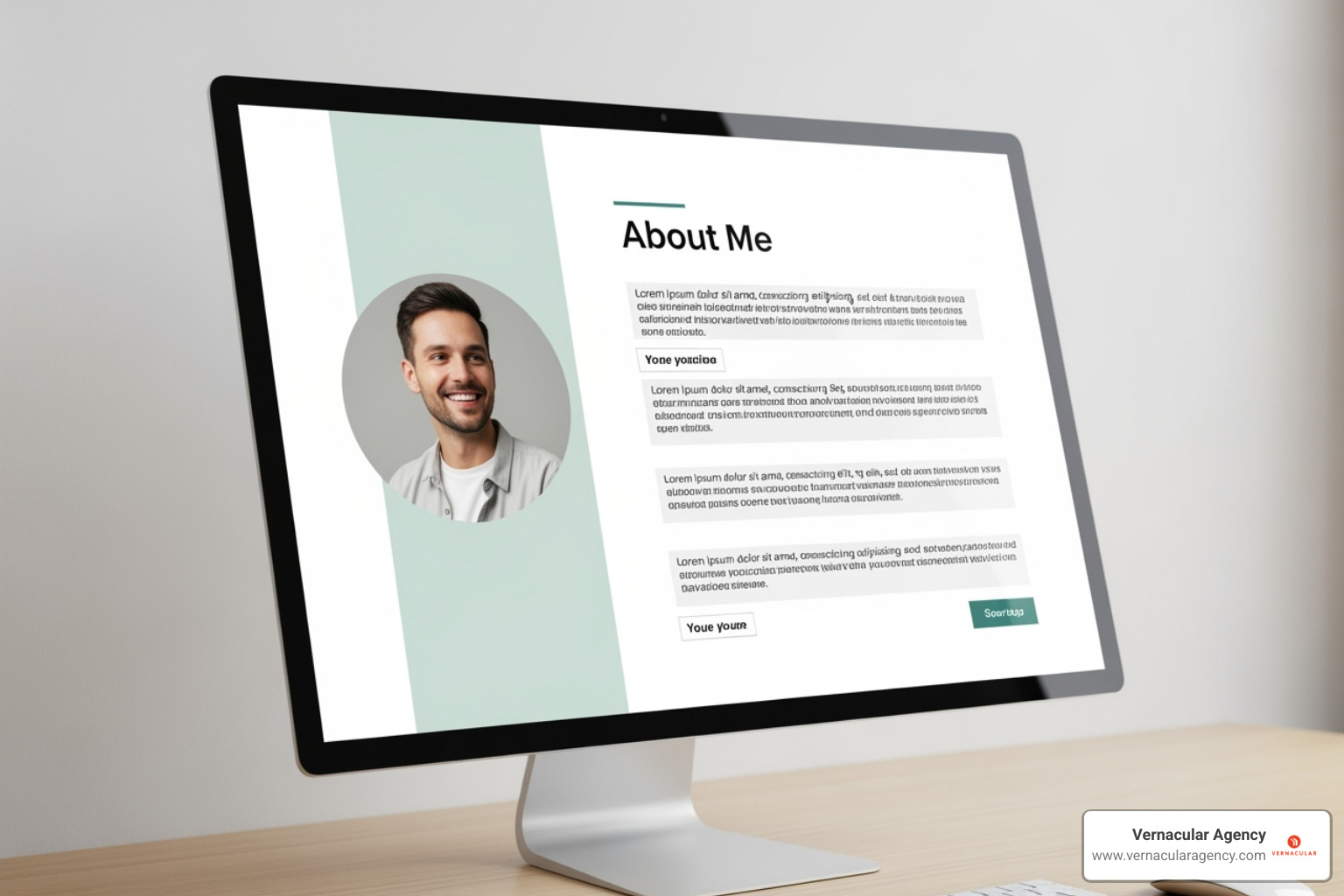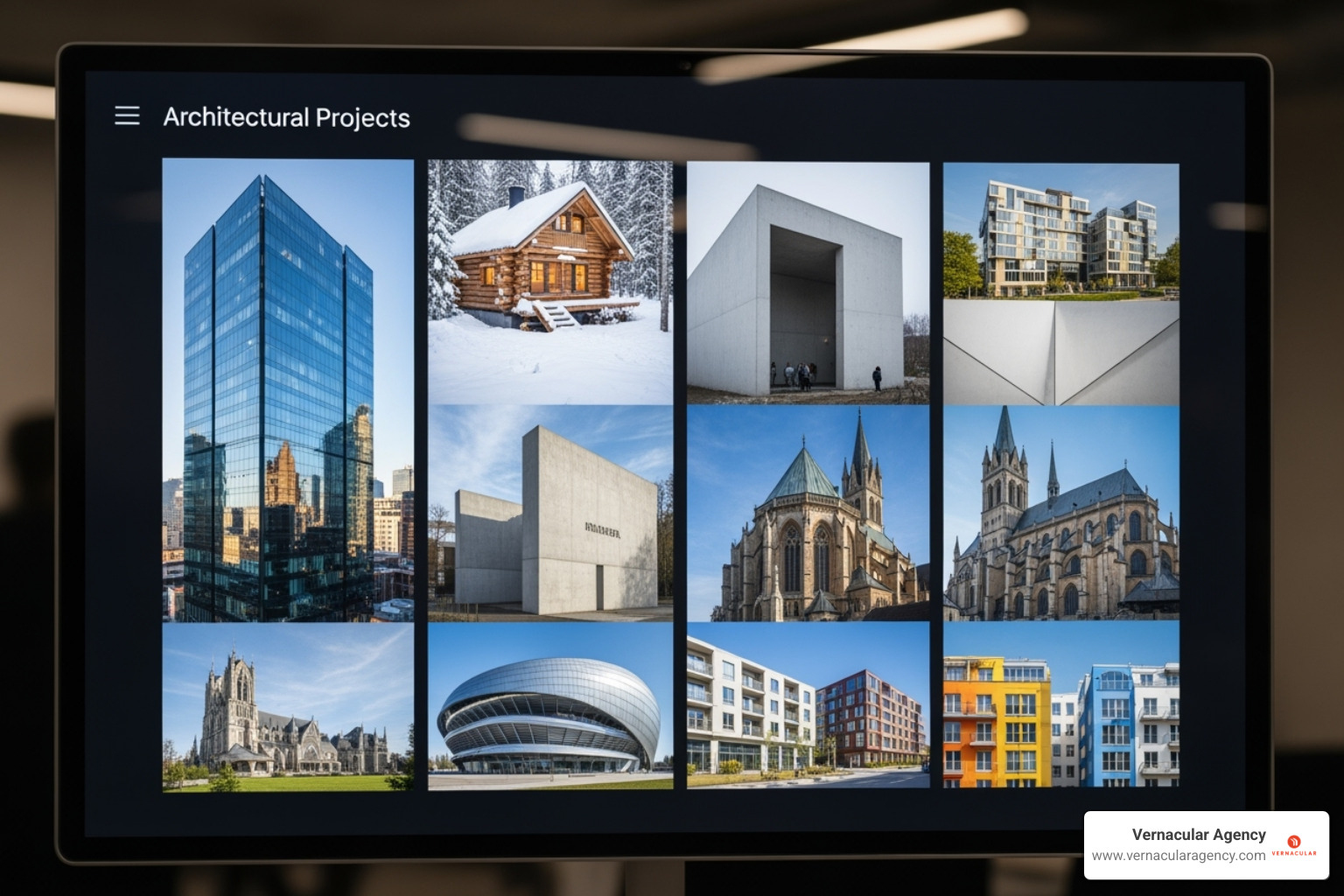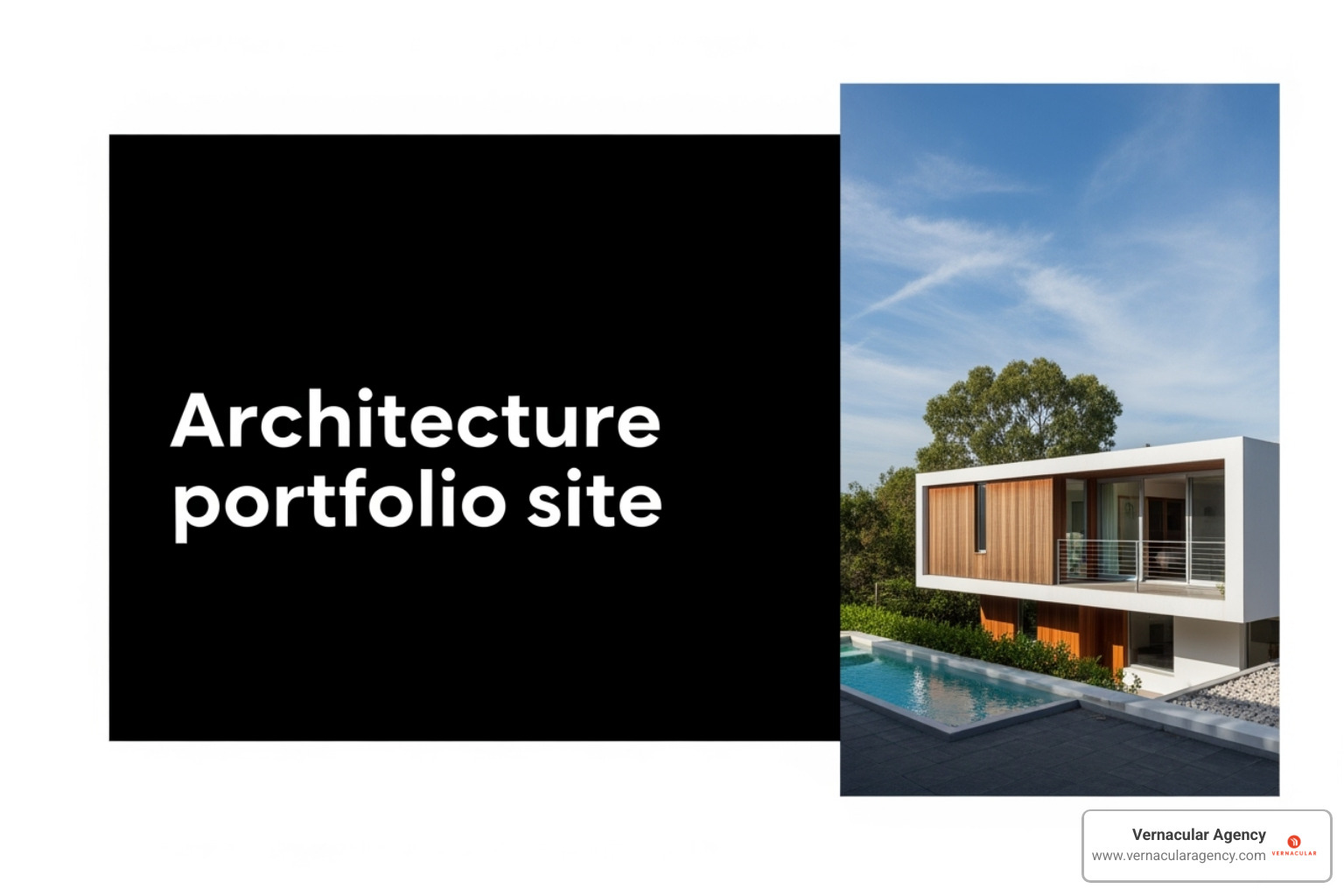An architecture portfolio site is your digital storefront - the first place potential clients and employers go to evaluate your design skills, creative vision, and professional credibility. Unlike a static PDF or printed portfolio, a well-crafted website showcases your work 24/7, reaches a global audience, and can be the deciding factor in landing your dream project or position.
Essential Components of a Winning Architecture Portfolio Site:
Research shows that having an online portfolio brings in 20% more job opportunities compared to traditional methods. Your architecture portfolio site serves as more than just a project showcase - it's your personal brand, marketing tool, and competitive advantage all rolled into one professional package.
In today's digital-first world, potential clients are increasingly looking for architects online. A well-designed portfolio website can showcase your work in a professional and engaging way, helping you attract new clients and grow your business. Whether you're a student preparing for your first internship or an established firm looking to expand your reach, your online presence can make or break opportunities.
I'm Rebecca Falzano, Creative Director with nearly 15 years of experience in content creation and design, helping creative professionals like architects build compelling digital narratives. Throughout my career working with designers, artists, and creative professionals, I've seen how a strategic architecture portfolio site can transform careers and business outcomes.

Know your architecture portfolio site terms:
Before you start building your architecture portfolio site, you need to make some smart strategic decisions. Think of this as the blueprint phase - getting these fundamentals right will save you headaches later and ensure your portfolio actually works for your career goals.
What separates a great portfolio from a forgotten one? Start with curated projects. Be selective; quality always trumps quantity. Five to ten of your strongest projects make a bigger impact than twenty mediocre ones. Each project should tell a story about your range and expertise, showcasing something unique about your skills.
High-quality visuals are non-negotiable. Your work is visual, so poor photography can sink a brilliant design. Invest in professional photos of completed projects, and include process work like sketches, 3D models, and technical drawings to show how you think.
Your design philosophy is what makes you unique. Whether you focus on sustainability, minimalism, or natural elements, this thread should weave through your site, explaining not just what you build, but how you think.
The About page is for human connection. A professional headshot, a compelling bio, and a touch of personality help build trust. People hire people they like.
Finally, make your contact information impossible to miss. Place it on your About page, a contact page, and in the site footer so interested clients can easily reach you.
Building a cohesive brand means all these elements should work together harmoniously. For deeper insights on this, check out A guide to building your brand.

A common question is whether to build a website or create a PDF portfolio. The answer is you need both, but for different purposes.
| Feature | Website Portfolio | PDF Portfolio |
|---|---|---|
| Interactivity | Highly interactive, clickable links, dynamic content | Static, limited interactivity |
| Updatability | Easy to update and share latest work instantly | Requires re-exporting and re-sharing every change |
| Multimedia | Seamlessly integrates videos, 3D models, animations | Limited multimedia, often requires external links |
| Accessibility | Accessible globally 24/7 with an internet connection | Requires download, can be large files |
| SEO Benefits | Findable via search engines, builds online presence | No inherent SEO value |
| Shareability | Shareable via a simple URL | Shareable as an attachment, can hit file size limits |
| Control | Full control over user experience and presentation | Fixed layout, less control over viewing environment |
A website portfolio is your 24/7 marketing tool. It’s interactive, searchable, and can showcase multimedia like video walkthroughs that bring designs to life. Crucially, it’s findable by potential clients using search engines. You can also update it instantly with new projects or awards.
PDF portfolios are ideal for direct sharing, like in email attachments for job applications or specific proposals. They allow you to create targeted presentations with only the most relevant projects for an opportunity.
The winning strategy is a hybrid approach. Use a comprehensive architecture portfolio site as your master showcase. From there, create focused PDF versions for specific applications. This approach offers maximum flexibility.
Your choice of platform and domain name impacts your professional image and findability. While DIY builders are an option, architects wanting a unique, high-performing site that reflects their brand find that professional web development services are the smartest investment.
At Vernacular Agency, we create custom-designed sites that are beautiful, functionally robust, and SEO-optimized. We handle the technical details—fast load times, flawless mobile performance, and unrestricted file sizes—so you can focus on designing amazing buildings.
Your domain name is your digital address. Choose one that is professional and on-brand, ideally your firm or personal name. Keep it simple and memorable. While keywords like "architect" can help with search visibility, your brand name should come first (e.g., "yourfirmname.com"). Avoid complex or long names.
Getting the foundation right with professional development and a strong domain sets you up for success. For more insights on effective design strategies, check out Tips on website design for architects.
Here, we dive into the creative process of presenting your work in a way that captivates and convinces potential clients and employers.
An exceptional architecture portfolio site tells a coherent story. The magic is in the curation process. Act as the curator of your own design museum, selecting 5-10 projects that showcase your absolute best work and demonstrate your range.

Each project needs a compelling story. Don't just show images; explain the journey. Use a problem-solution-result framework to help potential clients understand not just what you create, but how you solve real-world challenges.
Pull back the curtain on your creative process. Include initial sketches to show your hand skills and creative thinking. Display 3D models with interactive views to let visitors explore your designs. These behind-the-scenes glimpses add depth and demonstrate your technical skills.
In architecture, you're judged by what people see. Your architecture portfolio site lives or dies by its visual quality.
Professional architectural photography is essential, not optional. A skilled photographer can capture the interplay of light, shadow, and space that makes architecture come alive. It's an investment that pays dividends.
Your renderings must be crisp and atmospheric, while 3D models can offer an immersive experience. Video walkthroughs add another dynamic layer, guiding viewers through your design logic and holding their attention.
The secret is consistency. A cohesive visual language across your rendering style, color palette, and photography reinforces your brand and shows attention to detail—a quality clients value. Investing in quality visuals communicates that you care about every aspect of your work, from concept to final presentation. A minimalist design, for example, can make powerful visuals shine.
Think of your architecture portfolio site structure like the flow through one of your buildings - it should be intuitive, purposeful, and create moments of delight along the way.
Your homepage is your grand entrance. Feature your most striking project image or a curated slideshow to immediately communicate your design quality and style. This is your "wow" moment.
Each project deserves a dedicated project page with your best photography, renderings, process sketches, and a compelling narrative. Think of each page as a mini-case study.
Navigation should be intuitive. Simple categories like "About," "Projects," and "Contact" work best. Consider organizing projects by category (e.g., residential, commercial) so clients can find relevant work.
White space is your friend. Clean, minimalist layouts let your work take center stage. Your choice of typography also matters; use clean, readable fonts that complement your visuals.
For inspiration on how successful architects have structured their sites for maximum impact, explore these Great architecture websites for inspiration.
A beautiful portfolio is useless if no one can find it or use it. This section focuses on the technical and marketing aspects that drive visibility and engagement.
A potential client finds your site, loves your work, but then... it's unusable on their phone or takes forever to load. A flawless user experience (UX) is as critical as a beautiful design.
Mobile-responsiveness is essential, as nearly half of all web traffic is mobile. If your site doesn't work on a smartphone, you're turning away a huge portion of your audience.
Fast loading speed is crucial for first impressions. Visitors will leave if your high-resolution images take too long to load, so images must be optimized.
Intuitive navigation should be effortless. Clear menus and logical organization let visitors focus on your designs, not on figuring out your website.
Don't forget accessibility. Your site should welcome everyone—follow the Web Content Accessibility Guidelines (WCAG). This includes descriptive alt text for images (which also helps SEO), good color contrast, and keyboard navigation. It's professional and the right thing to do.

The most stunning architecture portfolio site is useless if no one finds it. Smart SEO and marketing are key.
Avoid common mistakes: poor-quality images, dense text, confusing navigation, ignoring mobile users, and hard-to-find contact info.
Basic SEO for architects isn't complex. Start with keywords potential clients search for, like "residential architect [your city]." Use them naturally in project descriptions and headings.
Image alt text is a secret weapon. Describe each image (e.g., "Modern farmhouse design in coastal Maine") to help search engines understand your visuals and improve accessibility.
Your project descriptions should be concise but detailed, including project type, location, and key features.
Your architecture portfolio site is a 24/7 marketing tool. Share your URL everywhere—email signatures, business cards, social media. Keep it updated to show you're an active, evolving practice.
For deeper insights into boosting your online presence, explore these SEO strategies for architects.
In architecture, trust is everything. Your architecture portfolio site must communicate reliability and professional standing.
Testimonials are powerful social proof. A few quotes from happy clients highlighting your process, timeliness, or communication can be incredibly persuasive.
Showcase your awards and recognition. Design competition wins, features in publications, or sustainability certifications are professional credentials that set you apart.
Press mentions and publications also build credibility. Create a dedicated section for media coverage, perhaps with an "As Seen In" banner featuring logos of prominent publications.
These trust signals paint a picture of a successful, respected architect, helping potential clients feel confident in reaching out. Established firms often feature their credentials prominently, and the award-winning sites we develop at Vernacular Agency are great examples of this principle in action.
Your architecture portfolio site needs regular tending. Aim to update it every 6-12 months or whenever you complete a major project. Regular updates show career progression and signal to search engines that your site is current, which helps with SEO. An outdated portfolio can raise questions, so focus on keeping it fresh with your best new work.
As a student or emerging professional, your architecture portfolio site should showcase your potential and design process.
A blog isn't mandatory, but it can be a powerful tool if you're committed to maintaining it. A well-kept blog showcases your expertise on topics like design trends or sustainability, positioning you as a thought leader. It also provides significant SEO benefits by adding fresh, keyword-rich content to your site. Finally, a blog helps build your personal brand by sharing your unique perspective and design philosophy. If you enjoy writing, it's a great asset; if not, focus your energy on your project presentations.
Your architecture portfolio site is more than a gallery; it's your professional story, your digital handshake, and the key to your next career milestone. By curating your best work, telling compelling stories, and ensuring a flawless user experience, you create a living document that represents who you are as a designer.
This site works for you 24/7, evolving with your career as you add new projects and achievements. A professional, mobile-responsive, and SEO-optimized online presence is no longer optional—it's essential for any architect who wants to thrive.
Here at Vernacular Agency, based in Portland, Maine, we understand the challenges architects face. We specialize in creating dynamic brand identities, advertising, and SEO-optimized websites that capture your unique design philosophy. Our comprehensive approach, from brand definition to media placement, helps architects like you make an impact.
We've seen how a powerful architecture portfolio site can transform a career by creating meaningful connections with the right clients. Your portfolio is your most important marketing tool, and it deserves to be built right. Ready to build a portfolio site that gets results? Explore our web development services.